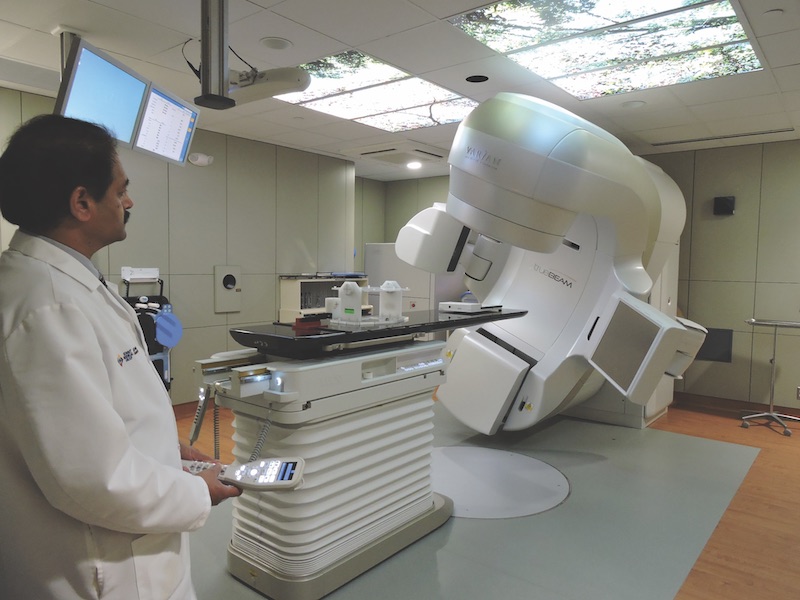On November 29, Summit Medical Group MD Anderson Cancer Center opened a 6,115-sf radiation oncology department within its campus in Berkeley Heights, N.J. This treatment center—half new construction, half renovation of a building that had been used for family services—is “important for Summit in terms of expanding its comprehensive treatment program,” says David Fernandez, Vice President of Oncology Services for Summit Health Management.
The building is also a “benchmark,” he says, in Summit’s broader relationship with Houston-based University of Texas MD Anderson Cancer Center, one of the largest cancer treatment networks in the country.
A significant trend in cancer care finds large healthcare systems branching out by affiliating with regional hospitals and medical centers to open jointly named satellite departments and clinics in suburban and even exurban markets.
“Healthcare systems are absolutely looking at cancer care as a business from an expansion standpoint, because they don’t want to lose their patient base” to a more conveniently located competitor, says John Alsentzer, Project Manager in the Nashville, Tenn., office of Smith Seckman Reid, which has been getting “quite a few RFPs for cancer centers” lately.
Satellites are driven by the needs of the outpatient community primarily, explains Andrew Quirk, Senior Vice President and National Director for Skanska USA in Nashville. “Even Memorial Sloan Kettering is making a huge effort to capture that marketplace.”
Quirk points, by way of example, to the 207,000-sf McKinley Outpatient Treatment facility, a $68 million Skanska project that opened last fall about a mile from H. Lee Moffitt Cancer Center’s campus in Tampa, Fla. “Moffitt saw the need to get out into the marketplace,” says Quirk. And by consolidating its outpatient services into one six-story building, Moffitt freed up space to expand its main hospital on the University of South Florida campus.
This outpatient center’s services include phlebotomy, transfusion, screening and diagnostic mammography, MRI, bone-density testing, surgery, a pharmacy, and genetic risk assessment.
Los Angeles-based Cedars-Sinai Hospital is improving a previously unoccupied new building in the L.A. suburb of Tarzana to a three-floor, 30,000-sf cancer center that, when it opens later this year, will include doctors offices, four pods with double-sided exam rooms, an infusion room with 30 chairs, a pharmacy, labs, and lounges.
Doss Mabe, a Partner with ZGF, the architect on this project, says Cedars-Sinai has several build-to-suit or tenant-improvement satellite cancer centers either opened or in the works around L.A. He describes these as the “front door” to the healthcare system’s cancer care.
“It’s a very different design proposition” from larger cancer centers, says Mabe. Patients often view a neighborhood facility as they would a spa. Satellites are also designed for quicker construction, as speed to market is an important competitive criterion, he says. Cedars-Sinai is also hedging its bets by leasing the Tarzana property for only 10 years.
E.W. Howell Construction was recently awarded the Southampton Hospital-Phillips Family Cancer Center, the first of its kind to be located on the east end of Long Island, N.Y. The two-story, 12,000-sf building is designed like a traditional barn that is commonly found in this market.
“Southampton wanted to bring this closer to its patients, so they won’t have to travel so far,” says Robert Timperio, Vice President and head of E.W. Howell’s healthcare division. The cancer center will include a LINAC and CT/simulation room, radiation oncology, four exam rooms on the first floor and three on the second, an infusion room with 14 chairs, conference rooms, and office space.
Timperio says Southampton Hospital is opening this satellite at a time when a number of Manhattan-based healthcare systems are coming to Long Island with outpatient centers.
The cancer center as a “franchise”
HDR did MD Anderson’s master plan, and Jon Crane, a Senior Vice President in the AE firm’s Atlanta office, reveals that the hospital’s growth strategy includes opening regional cancer centers domestically and internationally that range from 100,000 to 200,000 sf, and can handle a host of treatments.
Summit is currently collaborating with MD Anderson on a 130,000-sf outpatient facility under construction in Florham Park, N.J., that’s scheduled to open later this year. Its multidisciplinary menu of services will include radiation oncology, medical oncology, gynecological oncology, infusion, diagnostic imaging, mammography, and plastic surgery. Florham Park will also have a resource center that is accessible to patients and staff, and connects both to MD Anderson.
When asked why it chose to partner with MD Anderson, Summit’s Fernandez says the arrangement “is more like a franchise,” with specific design and programming criteria. He also says the partnership accentuates Summit’s commitment to support a consistently high level of service. “And, as we grow, they grow,” he says.
Molly Gabel, MD, Summit’s Medical Director of Radiology Services, was brought on board to help Summit set up its radiation oncology practice. She was instrumental in the design of the Berkeley Heights radiation oncology facility, which Summit submitted to MD Anderson for approval. The building took 18 months to complete.
Walking the new facility with a BD+C reporter, Gabel singles out little details, like the light-wood flooring and a closet in the hallway near the reception area, as examples of “softer” design touches that help put patients at ease.
The department is designed in a circle so that every patient passes a long nurses’ station before entering one of its three exam rooms or its treatment room. The department’s LINAC vault—one of the few in the country to combine a PET/CT scanner and High Dose Radiation machine in one room—is made somewhat less imposing by a backlit mural in the ceiling and an adjacent small outdoor garden area.
“Cancer care is a moving target, with discoveries being made all the time,” says Joseph Saphire, AIA, Partner, Saphire + Albarran Architecture, this project’s architect. “But the most important thing is still the patient experience and treating them with a great deal of respect, so they don’t feel like they’re being herded into a pen.”
The Berkeley Heights facility, with a 16-person staff, is currently handling 30-35 patients per day, with 60 being its capacity, says Fernandez.
Related Stories
| Oct 18, 2010
World’s first zero-carbon city on track in Abu Dhabi
Masdar City, the world’s only zero-carbon city, is on track to be built in Abu Dhabi, with completion expected as early as 2020. Foster + Partners developed the $22 billion city’s master plan, with Adrian Smith + Gordon Gill Architecture, Aedas, and Lava Architects designing buildings for the project’s first phase, which is on track to be ready for occupancy by 2015.
| Oct 13, 2010
Prefab Trailblazer
The $137 million, 12-story, 500,000-sf Miami Valley Hospital cardiac center, Dayton, Ohio, is the first major hospital project in the U.S. to have made extensive use of prefabricated components in its design and construction.
| Oct 13, 2010
Hospital tower gets modern makeover
The Wellmont Holston Valley Medical Center in Kingsport, Tenn., expanded its D unit, a project that includes a 243,443-sf addition with a 12-room operating suite, a 36-bed intensive care unit, and an enlarged emergency department.
| Oct 13, 2010
Hospital and clinic join for better patient care
Designed by HGA Architects and Engineers, the two-story Owatonna (Minn.) Hospital, owned by Allina Hospitals and Clinics, connects to a newly expanded clinic owned by Mayo Health System to create a single facility for inpatient and outpatient care.
| Oct 13, 2010
Maryland replacement hospital expands care, changes name
The new $120 million Meritus Regional Medical Center in Hagerstown, Md., has 267 beds, 17 operating rooms with high-resolution video screens, a special care level II nursery, and an emergency room with 53 treatment rooms, two trauma rooms, and two cardiac rooms.
| Oct 13, 2010
Cancer hospital plans fifth treatment center
Construction is set to start in December on the new Cancer Treatment Centers of America’s $55 million hospital in Newnan, Ga. The 225,000-sf facility will have 25 universal inpatient beds, two linear accelerator vaults, an HDR/Brachy therapy vault, and a radiology and imaging unit.
| Oct 13, 2010
New health center to focus on education and awareness
Construction is getting pumped up at the new Anschutz Health and Wellness Center at the University of Colorado, Denver. The four-story, 94,000-sf building will focus on healthy lifestyles and disease prevention.
| Oct 13, 2010
Community center under way in NYC seeks LEED Platinum
A curving, 550-foot-long glass arcade dubbed the “Wall of Light” is the standout architectural and sustainable feature of the Battery Park City Community Center, a 60,000-sf complex located in a two-tower residential Lower Manhattan complex. Hanrahan Meyers Architects designed the glass arcade to act as a passive energy system, bringing natural light into all interior spaces.
| Oct 12, 2010
Holton Career and Resource Center, Durham, N.C.
27th Annual Reconstruction Awards—Special Recognition. Early in the current decade, violence within the community of Northeast Central Durham, N.C., escalated to the point where school safety officers at Holton Junior High School feared for their own safety. The school eventually closed and the property sat vacant for five years.
| Sep 13, 2010
Palos Community Hospital plans upgrades, expansion
A laboratory, pharmacy, critical care unit, perioperative services, and 192 new patient beds are part of Palos (Ill.) Community Hospital's 617,500-sf expansion and renovation.
















